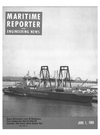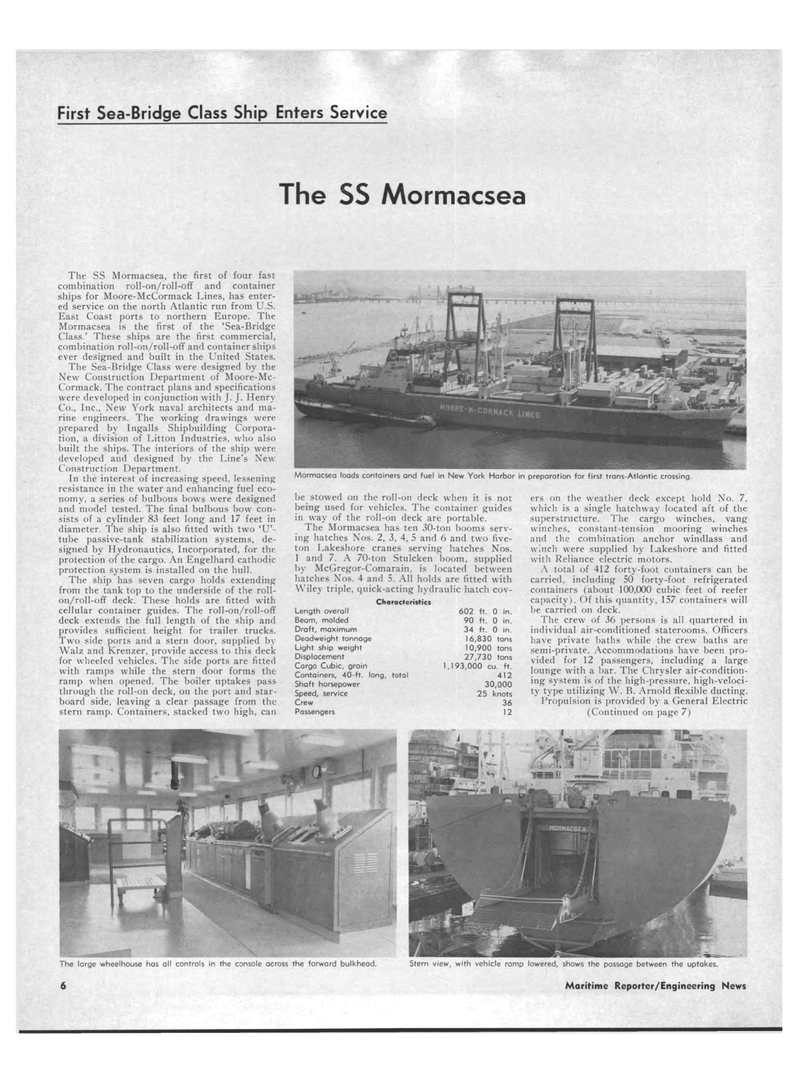
Page 4: of Marine News Magazine (June 1969)
Read this page in Pdf, Flash or Html5 edition of June 1969 Marine News Magazine
First Sea-Bridge Class Ship Enters Service "he SS Mormacsea The large wheelhouse has all controls in the console across the forward bulkhead. Stern view, with vehicle ramp lowered, shows the passage between the uptakes. The SS Mormacsea, the first of four fast combination roll-on/roll-off and container ships for Moore-McCormack Lines, has enter-ed service on the north Atlantic run from U.S. East Coast ports to northern Europe. The Mormacsea is the first of the 'Sea-Bridge Class.' These ships are the first commercial, combination roll-on/roll-ofF and container ships ever designed and built in the United States. The Sea-Bridge Class were designed by the New Construction Department of Moore-Mc-Cormack. The contract plans and specifications were developed in conjunction with J. J. Henry Co., Inc., New York naval architects and ma-rine engineers. The working drawings were prepared by Ingalls Shipbuilding Corpora-tion, a division of Litton Industries, who also built the ships. The interiors of the ship were developed and designed by the Line's New Construction Department. In the interest of increasing speed, lessening resistance in the water and enhancing fuel eco-nomy, a series of bulbous bows were designed and model tested. The final bulbous bow con-sists of a cylinder 83 feet long and 17 feet in diameter. The ship is also fitted with two 'U'-tube passive-tank stabilization systems, de-signed by Hydronautics, Incorporated, for the protection of the cargo. An Engelhard cathodic protection system is installed on the hull. The ship has seven cargo holds extending from the tank top to the underside of the roll-on/roll-ofF deck. These holds are fitted with cellular container guides. The roll-on/roll-ofF deck extends the full length of the ship and provides sufficient height for trailer trucks. Two side ports and a stern door, supplied by Walz and Krenzer, provide access to this deck for wheeled vehicles. The side ports are fitted with ramps while the stern door forms the ramp when opened. The boiler uptakes pass through the roll-on deck, on the port and star-board side, leaving a clear passage from the stern ramp. Containers, stacked two high, can Mormacsea loads containers and fuel in New York Harbor in preparation for first trans-Atlantic crossing. be stowed on the roll-on deck when it is not being used for vehicles. The container guides in way of the roll-on deck are portable. The Mormacsea has ten 30-ton booms serv-ing hatches Nos. 2, 3, 4, 5 and 6 and two five-ton Lakeshore cranes serving hatches Nos. 1 and 7. A 70-ton Stulcken boom, supplied by McGregor-Comarain, is located between hatches Nos. 4 and 5. All holds are fitted with Wiley triple, quick-acting hydraulic hatch cov-Choracteristics Length overall 602 ft. 0 in. Beam, molded 90 ft. 0 in. Draft, maximum 34 ft. 0 in. Deadweight tonnage 16,830 tons Light ship weight 10,900 tons Displacement 27,730 tons Cargo Cubic, grain 1,193,000 cu. ft. Containers, 40-ft. long, total 412 Shaft horsepower 30,000 Speed, service 25 knots Crew 36 Passengers 12 ers on the weather deck except hold No. 7, which is a single hatchway located aft of the superstructure. The cargo winches, vang winches, constant-tension mooring winches and the combination anchor windlass and winch were supplied by Lakeshore and fitted with Reliance electric motors. A total of 412 forty-foot containers can be carried, including 50 forty-foot refrigerated containers (about 100,000 cubic feet of reefer capacity). Of this quantity, 157 containers will be carried on deck. The crew of 36 persons is all quartered in individual air-conditioned staterooms. Officers have private baths while the crew baths are semi-private. Accommodations have been pro-vided for 12 passengers, including a large lounge with a bar. The Chrysler air-condition-ing system is of the high-pressure, high-veloci-ty type utilizing W. B. Arnold flexible ducting. Propulsion is provided by a General Electric (Continued on page 7) 6 Maritime Reporter/Engineering News

 3
3

 5
5
